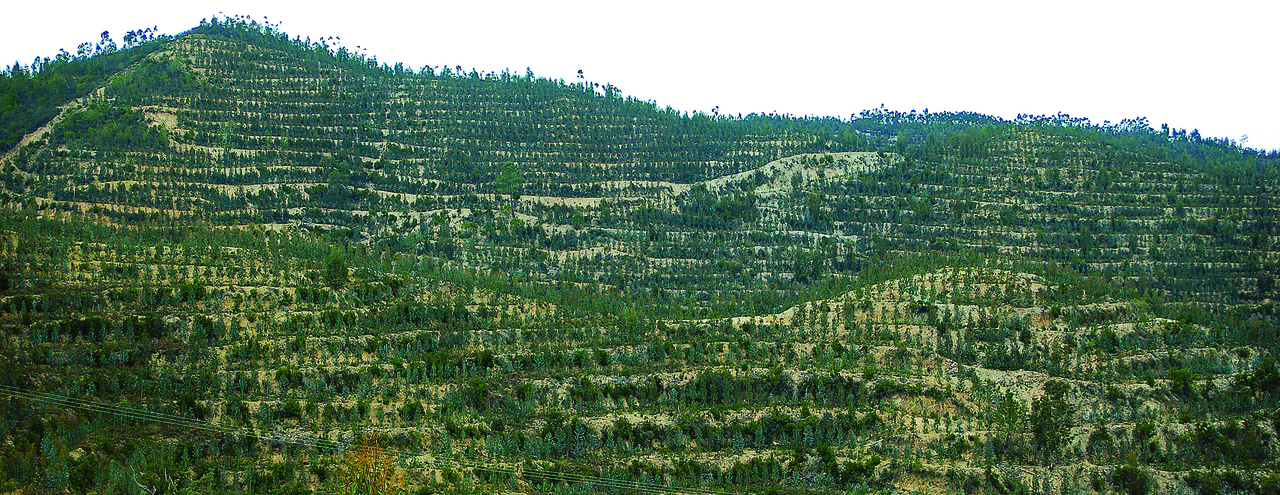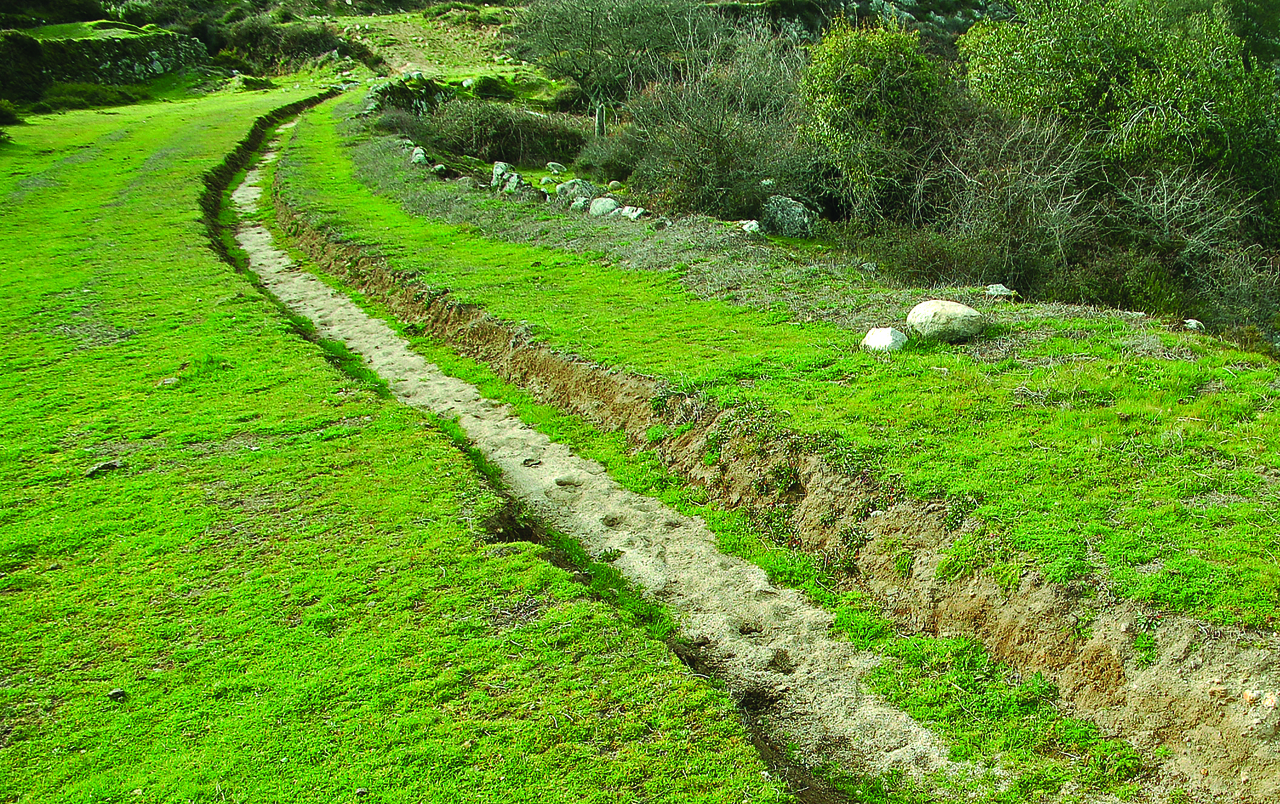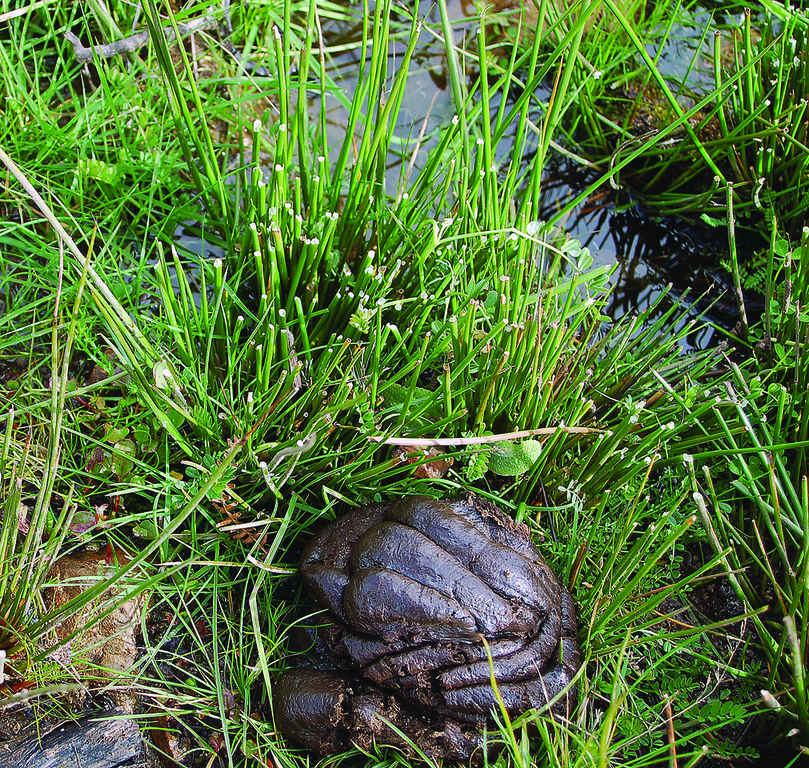The photos are clear. Two employees of the municipality of Monchique are spraying herbicides onto public pavements. The two men suspect perhaps that they are doing something they shouldn’t, because otherwise they wouldn’t be wearing white full-body suits, mouth protection or gloves. They are protecting themselves – but who is protecting the people, plants and animals?
When I ask them why they’re doing that and if they know what they’re doing, they wave me away angrily. Clear off! they shout. But I stay. Less than 15 minutes later, a mother pushes her pram over just these cobblestones. A cat, a dog, some birds and above all insects come into contact with this poison. With the next rain, it will penetrate deep into the ground, and in this way ends up in the groundwater. The poison was actually intended to destroy just the grass and moss between the stones.
Most of the village inhabitants who are just passing watch and then look away quickly. In this way, the poison is out of sight, and also out of mind again. Suppression is a common method of finding relief. What cannot be, is also not allowed to be. But the poison seeps slowly into the ground and, with the next rain, will flow into the drains and the earth as contaminated water. Every year, a little bit more. Soon it will collect in the village’s underground water reserves. People who have a child here not only receive a 500 euro reward, they also get a little bit of just that poison to help them on their way. Is that the water that we will later drink?
According to the environmental authority APA (Agência Portuguesa do Ambiente), there are 62 underground aquifers in mainland Portugal. In 2016, the assessment of a five-year, long-term study revealed that 55 of these aquifers are already contaminated inter alia owing to industrial agriculture (ammoniacal nitrogen and nitrates), especially due to intensive livestock farming, fertilisers and pesticides/herbicides.¹ Whether genetically modified seeds are used, or artificial fertiliser, or whether pesticides, herbicides and fungicides are sprayed, in the end, everything gets into our water.
Mindfulness? It’s as if someone climbs a tree with a saw, sits on a branch and then saws it off. Ciao. Anyone who can read should have a look at the leaflet that comes with a package of herbicide. You might as well learn the telephone book off by heart. It is pointless learning to read at school and then not being able to recognise that the devil is called MonSanto & Co.
1 Source LUSA
“In the middle of a period of drought, the environmental association Zero went to analyse the quality of groundwater in the country and reached the sad conclusion that there is widespread pollution in most of the country’s aquifers. Furthermore, Zero says, the bad quality of this water is mainly due to agricultural production and intensive livestock farming, which could be preventing the use of the water for human consumption. Zero analysed the data provided by the Portuguese Environment Agency regarding the presence of ammoniacal nitrogen and nitrates in underground water in the period from 2011 to 2015, and discovered that all 55 of 62 aquifer systems for which data is available were polluted.” (…)

Very thirsty
Monchique is the only municipality in the Algarve whose schools skip the awareness-raising classes on the topic “Uso eficiente de água” given by the water company “Águas do Algarve SA.” They would know from these that eucalyptus, with its deep, fast-growing roots, sucks all the water out of the ground and transforms it into oil, which, for its part, is an efficient fire accelerant. It’s not the eucalyptus that is dug up; no, instead, a civil defence (Protecção Civil) tanker takes drinking water from the fire brigade hydrants in Caldas de Monchique to the parish cisterns in Marmelete and Alferce. They’ve run out of water, say the drivers of the tankers. 76 percent of the forest in the municipality of Monchique (396 km2, population 6,045, in 2011) consists of eucalyptus plantations. The topic has been a very controversial one for many years. Another question that travellers can’t stop thinking about during the journey is, if there are fires again this summer, where will the fire brigade get the water from to put out the fires with, if drinking water is already in short supply in February? Isn’t this a public issue for the socialist opposition in the Monchique town hall? Mayor Rui André, himself a board member of Águas do Algarve SA., will certainly have good answers to this question. He called off an ECO123 interview on the topic of water by SMS at short notice.

sowamo
Sowing water?
In Monchique, people are proud of their good spring water, which has been lying for centuries in the mountains of southern Portugal. Here and there, it emerges from springs and from the mountains and from under stones that the geologically and ecologically important mountains have conserved over many centuries. Water is a wonderful gift of nature. In recent years, however, life has changed somewhat: the climate, the atmosphere, the changeable weather, the temperatures, and on top of that the forest fires. None of that fits in with an intact world any more. In the past, it often used to rain a lot for weeks, you can still hear older people saying. Water shortage? Didn’t happen in the old days! But now last winter’s little rain is hardly sufficient to keep the municipal water supply going any longer. Because Monchique is one of the few municipalities in Portugal that still supply more than 95% of their own drinking water. Yet, in August 2017, this centuries-old success story came to an end. In two of the three parishes, first in Marmelete, and then later in Alferce too, for months on end drinking water had to be ferried in by the civil defence’s tanker (capacity – 16,000 litres), and several times a day, what’s more. So, what next, Mr. President?
So, what had been feared for many years has finally happened. Even in February, water is being transported around. Whether it’s the regular lack of rain or the excessive cultivation of water-consuming eucalyptus that is responsible for this can be discussed elsewhere. The fact is, however, that, even if this is disputed by municipal president Rui André at the council and with the press, Monchique has a water problem, even if it should still rain in the meantime. At the municipal council itself, everyone knows this. Something must happen, otherwise things will get very tight this summer. And whenever such a problem arises, a long-term solution is needed. It’s fortunate that, some years ago, a team of scientists were able to present their ideas about “sowing water” to the president, first of all in a face-to-face discussion and then in a scholarly study. Because the project that emerged from this needed a few years before it could be put into practice. Then, in 2015, it was time: finally, the funding had been achieved and it could start.
Actually, Rui André wanted to say something about this matter at this point. But then he called off the interview and delegated it to an employee in his administration. SOWAMO is a multi-disciplinary project for overcoming environmental problems that are exacerbated by climate change, the environmental engineer Sónia Gil tells ECO123, and provides a short tour of the site on Thursday afternoon, 25th January. SOWAMO is the successful attempt to get seven partners around one table, she says. In 2015, Monchique Council tasked the company Terra, Ambiente e Recursos Hídricos Lda. from Sacavém with planning the project. The project is scientifically monitored both by the University of Algarve (CCMAR) in Faro and by NIBIO, the Norwegian Institute of Bioeconomy Research in Ås, 30 kilometres south of Oslo. Norway is financing 85 percent of the project through its “EEA grants” fund (Iceland, Liechtenstein and Norway). That’s 168,941.39 euros. And the “Fundo Português do Carbono”, which the Agência Portuguesa do Ambiente (APA) is in charge of, has contributed 29,813.19 euros. The total cost is 198,754.58 euros.¹
The municipality of Monchique, the owner of the land and water protection area Relva do Carrapateiro, under which the water supplies and their aquifers lie, put the construction work out to tender on 17th November 2016. The contract was awarded to the company TECNOVIA, which started the earth-moving work on 9th March 2017. When asked whether the construction work that was completed on 26th April 2017 at a cost of 88,261.49 euros had already delivered the first positive results – among other things, a 330-metre-long, half open channel was built (see map) – the environmental engineer replied cautiously: that depends to a large extent on how much rain will still fall this spring.
The Monchique hills are one of several semi-arid regions in southern Europe; they have their own micro-climate, their own mountain springs, underground reservoirs, boreholes and aquifers. This includes Monchique’s own 126.6-kilometre-long, piped drinking water network for 2,373 households. The households consume around 300,000 m3 of water per year. And let’s be honest: the president is hoping for greater prosperity through increased nature tourism. That is another reason why the municipality is already consuming more water than it really has, despite the fact that more and more younger residents are moving to the cities. With SOWAMO, the hope is that water supplies in the hot summer months will be improved, or at least stabilised. According to the forecasts in the different scientific studies, if more water really is available, SOWAMO could increase the running water capacity in the summer by one litre of water per second (around 80 m3 per day). So much for the theory.
On the hilltops of Fóia (902m), over which clouds hang low and shed their rain for many days in the winter, water is supposed to be “sown”. People know all about sowing in Monchique, after all it’s a region that still lives from its agriculture. The site where SOWAMO is supposed to be installed is 800 metres above sea level. The weather can change here from one moment to the next and a wall of fog can descend. We look at the long, half-open channel that winds its way through the wilderness and which is supposed to redirect the water from the higher lying hills to the lower-lying water protection area, to Relva do Carrapateiro and Penedo do Buraco. The water storage capacity of the underground reservoirs and aquifers is supposed to be improved through the rainwater channel and through retention and infiltration basins. The goal is to make the municipality of Monchique’s water supply more resilient at a time of climate change. So far, so good

Water protection and biological diversity
The five-hectare “Relva do Carrepateiro” is an important water protection area in the Monchique hills, which has been badly affected by fires and extensive forestry and livestock farming. Francisco Leitão and Alexandre Teodósio of the University of Algarve (CCMAR) write that the plan for reforestation with indigenous trees and bushes with the goal of recovering biological diversity provides for at least twelve tree and plant species on a comparable site: including
• alder (Alnus glutinosa);
• walnut (juglans comun);
• ash (Fraxinus excelsior),
• holm-oak (Quercus rotundifolia) and cork-oak
(Quercus suber);
• olive (Olea europaea);
• sweet chestnut (Castanea sativa);
• elder (Sambucus nigra);
• blackberry (Rubus spec);
• ivy (hedera helix);
• grapevine (vitis spec) and the sharp-pointed rush
(Juncus acutus).
But before the first tree can be planted, a planting plan is needed from the local environmental association A Nossa Terra, which the municipal council has, in turn, to authorise. The environmental engineer Sónia Gil stressed to ECO123 that no trees may be planted in the immediate proximity of the underground reservoirs, adding that the area belonged to Rede Natura 2000 and was a biotope especially worth protecting.
The Norwegian authors of the SOWAMO project stressed to ECO123 that the large and long-term storage capacity of natural groundwater systems (aquifers) offered a solution to the problems that are arising (and have already arisen) in Monchique (and elsewhere) through climate change. It was a matter of continuously refilling the underground reservoirs. They emphasise that the strategic importance of groundwater for global water and food security will, in all probability, increase further with climate change, as more frequent and more intensive extremes of climate (droughts and floods) increase the variability of precipitation, soil humidity and surface water. The expectations of SOWAMO are high. As a pilot project, the hope is that SOWAMO can be repeated elsewhere if shown to be successful. Even if the pilot project proves to be a success, the acute water problems for the parishes of Marmelete and Alferce remain unsolved. Water is a topic that will be at the heart of all discussions this year.
² = … “In addition to the recharge it is expected to replace the eucalyptus by chestnut trees in the area immediately downstream of recharge structures, as this is a native and typical kind of flora of Monchique. The substitution of the type of vegetation will reduce the use of underground water, which will improve the water efficiency of the project…”
Source: ADaPT, April 2017
Summary of the field research:
One year after the end of the construction work, the site still looks like a building site. Trees and shrubs were dug up to build the channel and put to one side. Now they’re lying there. Two questions arise:
• Why is there a eucalyptus wood covering several thousand square metres in the lower part of the water protection area Relva do Carrapateiro and why was the eucalyptus not cut down and the roots dug up, as required by the ADaPT programme? Eucalyptus and groundwater do not go well together.²
As the site of the water protection area was given up many years ago by its inhabitants, it is in a very neglected state: blackberry bushes are turning into wild undergrowth and are meanwhile blocking important access routes, making the area especially susceptible to forest fires. And…
• Shouldn’t a water protection area be cared for continuously and be protected by a fence so that the most important resource on our planet, water, at least remains clean? ECO123 investigations have also shown that the water protection area is used directly as free pasture for cows. These dear creatures leave their manure and cowpats all over the place there. Near one underground reservoir, the brown water lies ankle deep, and stinks. Wild boar also romp around here and there. A water protection area doesn’t really look like that. Water is a common good, which is in short supply. People who want to implement a good plan here could and should be more careful in the way they deal with the ground, plants and water.
 Eco123 Revista da Economia e Ecologia
Eco123 Revista da Economia e Ecologia

